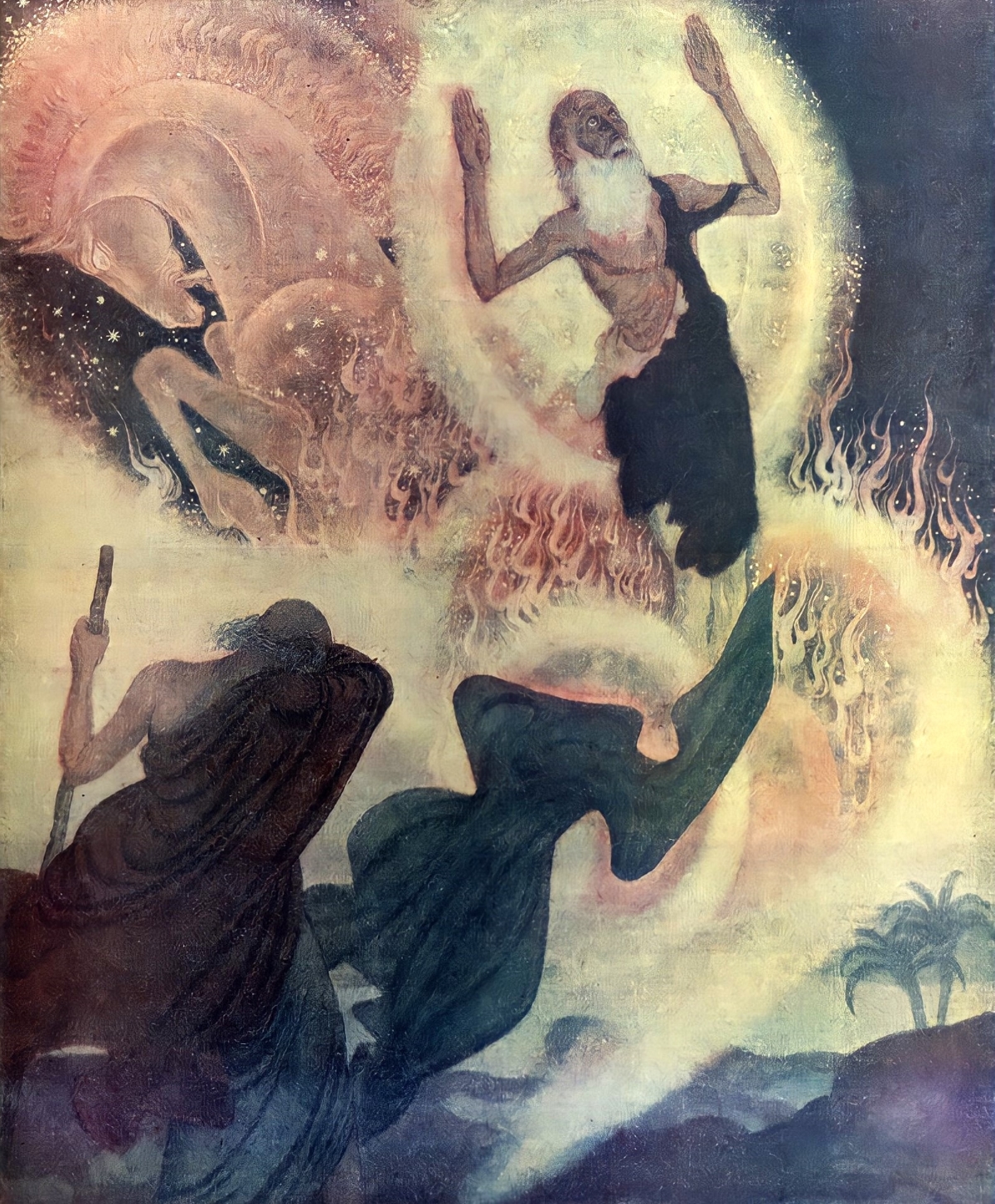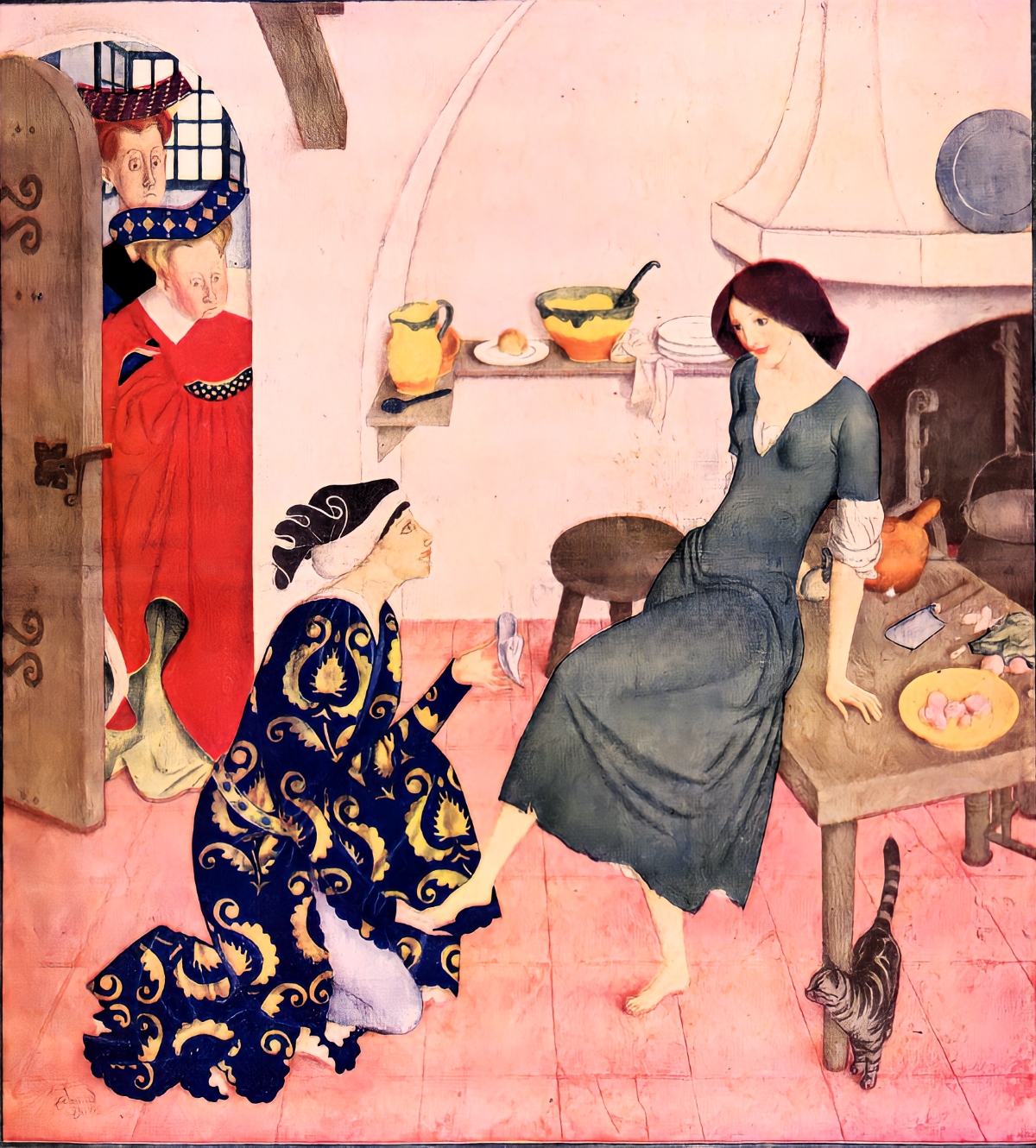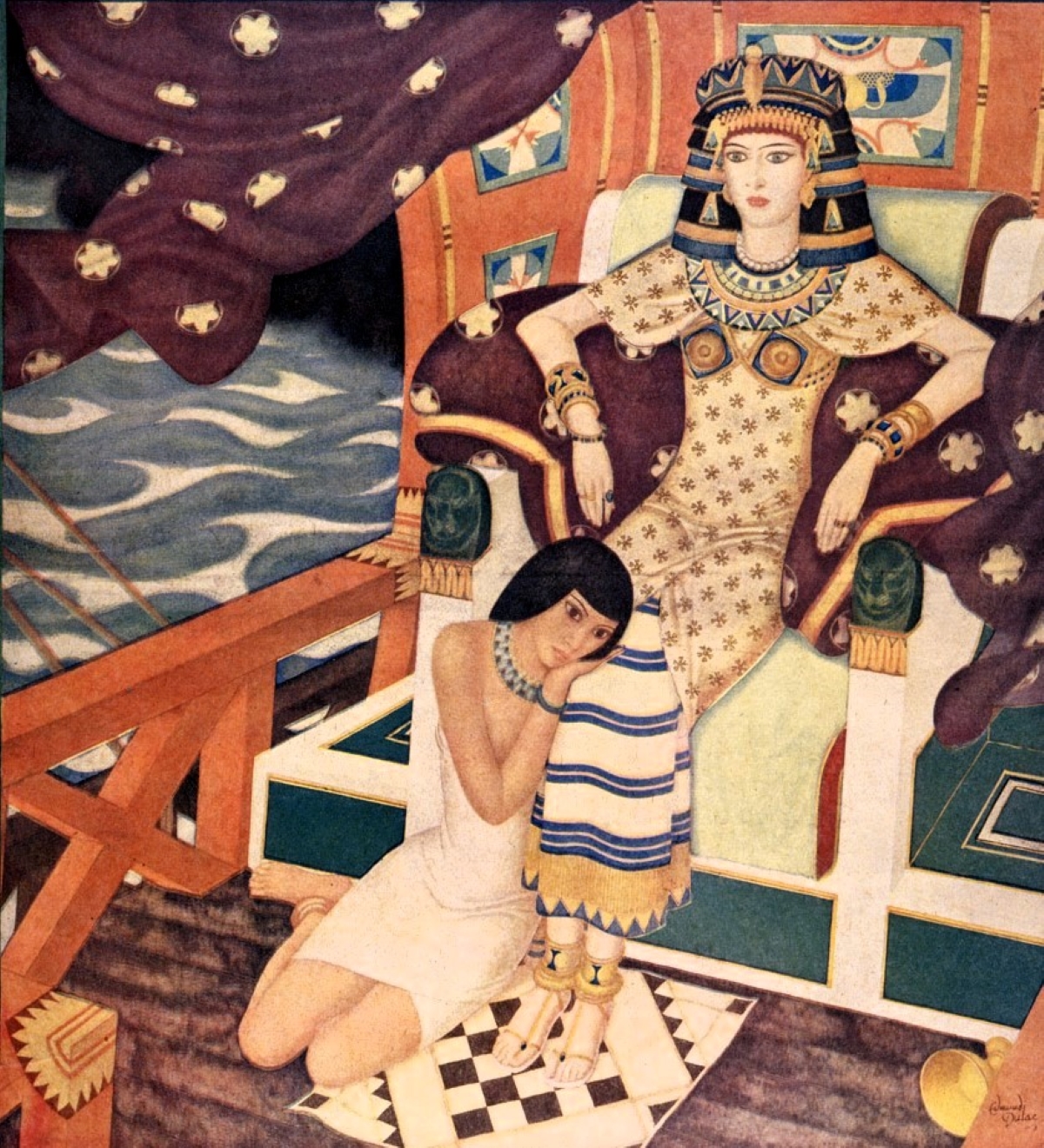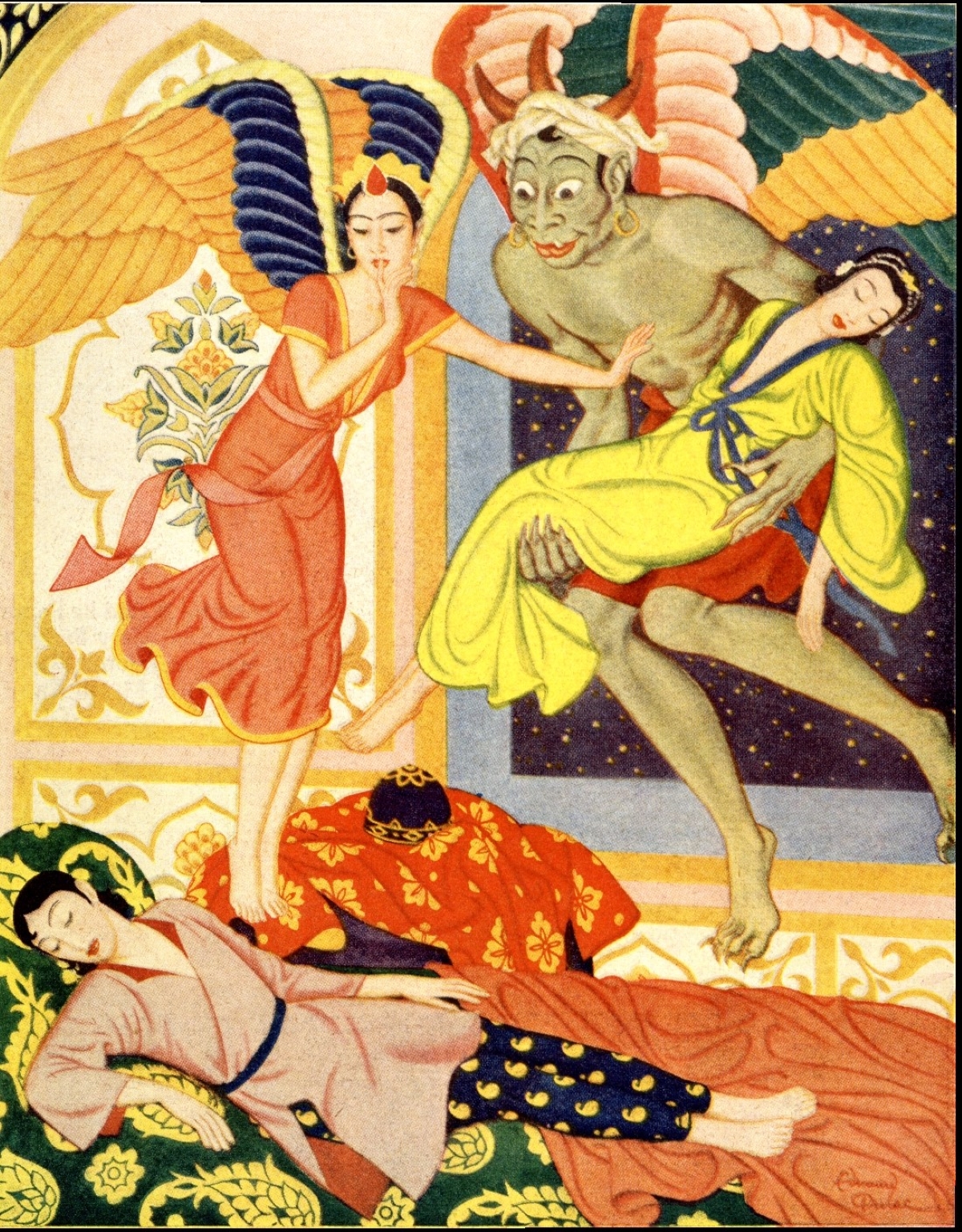Edmund Dulac is remembered today as one of the founding fathers of the Golden Age of Illustration, roughly from 1875-1925, writes Albert Seligman. His luxurious Gift Books of the early 20th century were covered in vellum and issued in signed limited editions with tipped-in color plates. Many were also published in American trade editions. But after the First World War, the gift book market evaporated and Dulac, like many other artists and illustrators, was financially challenged.
Dulac was born in Toulouse, France in 1882 and emigrated to England in 1904. He became a British subject in 1911. Although he never visited America, his work was known to the public and publishers. The Century Magazine used an illustration with a Rubaiyat caption for their October 1913 frontispiece. Martin Birnbaum, owner of the Scott and Fowles Gallery NY, opened a one man show for Dulac’s watercolors in 1916. The show included masks that Dulac designed for the Noh play At the Hawks Well written by William Butler Yates. Dulac’s illustrations appeared in Good Housekeeping, Ladies Home Journal and Harper’s Bazaar in the 1920s, and in 1922 he designed an elegant wall calendar overlaid with gilt and custom boxed for the Berwind White Coal Mining Company as a Christmas gift for their clients.
In November 1923, Ray Long, one of the editors for the W R Hearst Sunday supplement The American Weekly, offered Dulac a commission to paint an annual series, from eight to 12 illustrations, on a mutually agreed upon theme. The first series, Bible Scenes and Heroes, was to appear next year in Autumn of 1924.
Dulac’s contract lasted for 28 years. He painted thirteen series and 106 covers for the Sunday supplement. His final series was six illustrations for ‘The Arabian Nights’, a theme he often painted throughout his books and magazines. In 1951 The American Weekly ceased using paintings for their covers, and started using photography.
Collecting Edmund Dulac
My own involvement with The American Weekly covers was through a fortunate meeting with Ann C. Hughey, who published the complete Dulac bibliography (of his books) in 1995. At the time, I was an avid collector of Golden Age illustrators, and Dulac was my specialty. Ann wrote The American Weekly checklist for Colin White’s Dulac biography with all thirteen series and each issue by title and date. I was able to contact her through an East Coast book dealer, and she invited me to spend the weekend and see her collection. When I asked her to show me The American Weekly covers, she replied that no one has ever republished them since they first appeared. We thought it would be a worthwhile project to find and publish all the covers in one volume, for the benefit of fellow Dulac collectors and dealers.
Of course, we didn’t know where to find the original covers, as most of the newspapers from the 20s through the 50s were long gone. I was living in San Francisco and much of my book collection was provided by Bud Plant and Jim Vadeboncoeur, who were partners in the Fantastic Catalog, which Bud is still publishing today. Jim was planning to publish glossy magazines (Images) with Golden Age artists and had a small collection of American Weekly covers. (He wrote The American Weekly article for Wikipedia). Jim recommended I call Bill Blackbeard, who owned and operated The San Francisco Academy of Comic Art. Bill had the largest collection of comic art in the whole country, although I didn’t realize it at the time. He had all the Dulac American Weekly’s lying flat in his garage. Bill allowed us to remove the covers and have them professionally photographed. After he died in 2011, his entire seven-ton collection was removed to the Billy Ireland Cartoon Library and Museum at Ohio State University. (see the link in the Bibliography following)
Ann Hughey self-published her bibliography in 1995 and was starting on her second book, the Dulac magazine illustrations. We planned The American Weekly Covers to be her third book.
The photographers provided us with transparencies to use in making the printing plates for a full color publication. We made many submissions to art and comic publishers, but no one wanted to risk the money for such a large color run. This was long before the digital process revolutionized printing, and 10,000 book runs were the minimum for profitability. Reluctantly, we shelved the project, and it never went any further. Ann passed away in 2014, but wrote the introduction for the hard cover version of the book, which is complete, but still awaiting publication.
Only recently, I was informed by Pete Beard, who makes beautiful videos of artists and illustrators on his YouTube channel, that the transparencies could be digitized. (Any readers doubting my ability to function in the digital age are free to do so.) The link to his ‘The Fantasy Art of Edmund Dulac’ is in the Bibliography following the article.
I now have high resolution digital images, suitable for web or print publishing. My first project was an eBook of all 106 The American Weekly Covers, with only a short introduction. Our goal was to have something of reference for the collectors and the public to enjoy, and that fit the bill. I discovered with such high-resolution images there were more printing flaws than I first realized. The newspaper covers were all over seventy years old when we photographed them, and were not a high-quality printing job to begin with. So, I am slowly restoring the images, one series at a time, and publishing them individually. The entire collection will take some time, but seeing these beautiful watercolors restored for the first time in a century will be worth the time and expense.
For this article, I presented the series in chronical order, the oldest first, with two illustrations from each series. I added some brief comments on a few of the sections, and included the captions when available. The ‘Seven Tales from King Arthur’s Court’ and ‘8 Canterbury Tales’ stories by John Erskine and the final 1951 ‘Arabian Nights’ stories by Watson Crewes Jr. were printed in each issue, and are too long to include here.
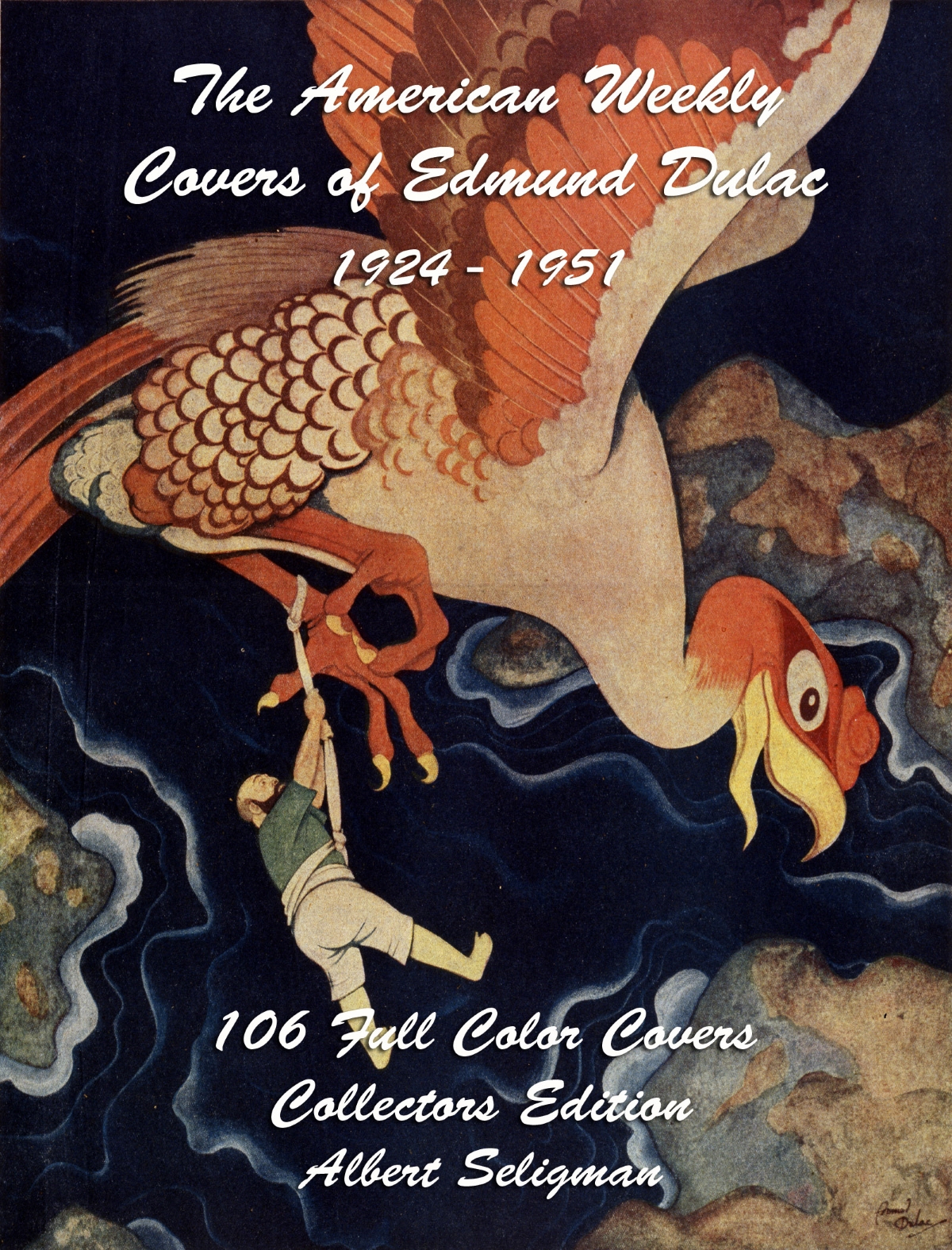
BIBLE SCENES AND HEROES, 1924
October 5 The Angel with the Flaming Sword drives
Adam and Eve out of Eden
October 12 Lot’s Wife Looks Back Upon the Cities of the
Plains and is Turned into a Pillar of Salt
October 19 The Infant Moses is found in the
Bulrushes by Pharaoh’s Daughter
October 26 The Walls of Jericho Fall Under
the Blast of Joshua’s Horn
November 2 Samson Pulls down upon Himself and the
Idolaters the Walls of Their Temple
November 9 Ruth Uncovers the Feet of Boaz
November 23 King Saul and the Witch of Endor
November 30 David and Goliath
December 7 The Judgment of Solomon
December 14 Elijah and the Chariot of Fire
December 21 Queen Ester and Haman
Colin White writes about The American Weekly series throughout in his Edmund Dulac biography (Studio Vista, London, 1976). These are his comments on Bible Scenes-
“The first series, described as being by, ‘The Distinguished English Artist Edmund Dulac’, appeared on 5 October 1924 with a well heralded but inauspicious opening titled “The Angel with the Fiery[sic.] Sword drives Adam and Eve out of Eden” which was redeemed only by the magnificent sword in the angel’s hand. There was some excuse for the weakness of this opening picture. Dulac had originally intended portraying “The Birth of Eve”, but his watercolor, which showed both Adam and Eve without navels, was considered controversial.”
White goes on to describe the problems Dulac faced with the reproduction method, which then enlarged the original by one third, which revealed weaknesses. This was a first attempt to reproduce watercolors in newsprint, which resulted in dull and faded colors. Dulac realized he had to change his technique to allow for the printing process and enlarged his originals so they could be reduced for added sharpness. He also settled for simpler designs with less detail. The rest of the series reproduced well, except for “Ruth” and “The Witch of Endor” which were a bit faded with poor color separation.
In two of the series Dulac experimented with cubism, started by Picasso and followed by many other artists. Both “Samson Pulls down the Pillars” and “The Fall of Jericho” show a scene of chaos perfect for the cubist rendering. All the elements are scattered and rearranged as they fall into place.
In 1930 Dulac started drawings for “The Book of Revelations” which he wanted to include as a series. He completed “The Four Horseman of the Apocalypse” and “The Scarlet Woman of Babylon” both in a rather morbid style for which he was unaccustomed. The series was never completed and his second Bible Stories was the lovely 1936 “Song of Solomon”.

The Judgment of Solomon
CHARACTERS FROM THE ARABIAN NIGHTS, 1925
March 15 Scheherazade–The Sultana
March 22 Aladdin and his Wonderful Lamp
March 29 The Caliph Haroun Al Raschid
April 5 Ali Baba
April 12 The Princess Badroulboudour–The Sweetheart of Aladdin
April 19 Morgania Pours the Boiling Oil on the Forty Thieves
April 26 The Prince and The Talking Bird
May 10 Sinbad the Sailor and the Roc
May 17 The Enchanted Horse
May 2 New Lamps for Old–Aladdin and the Wonderful Lamp
In 1907 Stories from the Arabian Nights was published by Hodder & Stoughton. The book’s 50 illustrations were commissioned by Leicester Galleries who retained the copyright and held an annual exhibition of Dulac’s paintings. The book was so popular that the first edition sold out in a month and had to be immediately reprinted.
This began Dulac’s reputation as an “orientalist” and throughout his career he returned to the oriental themed material for his paintings. Ann Hughey notes in her bibliography The Book Illustrations of Edmund Dulac-
“At various later intervals, Dulac painted new interpretations of the Arabian Nights stories, always refining his initial success, but never surpassing it. His picture ‘An Eastern Story Teller’ (Leicester Galleries 1908), his illustrations for The Rubaiyat, Princess Badoura and Sindbad the Sailor all display his talent for portraying eastern scenes. Almost none of his books were without oriental pictures: those for The Sleeping Beauty in ‘Blue Beard’ and ‘Beauty and the Beast’; those for Hans Andersen in ‘The Nightingale’, miscellaneous ones for The Red Cross Book, The Fairy Book and The Fairy Garland, and the ink drawings of The Green Lacquer Pavilion, to mention a few.” (Hughey 16)
Colin White relates in his biography Edmund Dulac that beginning with the 1925 Characters from the Arabian Nights all the female and some male characters were really portraits of his live-in companion Helen Beauclerk. She has elongated features and high cheekbones, and can be plainly seen as Scheherazade and Princess Badoura, painted 25 years apart. Their partnership endured until Dulac’s fatal heart attack in 1953.
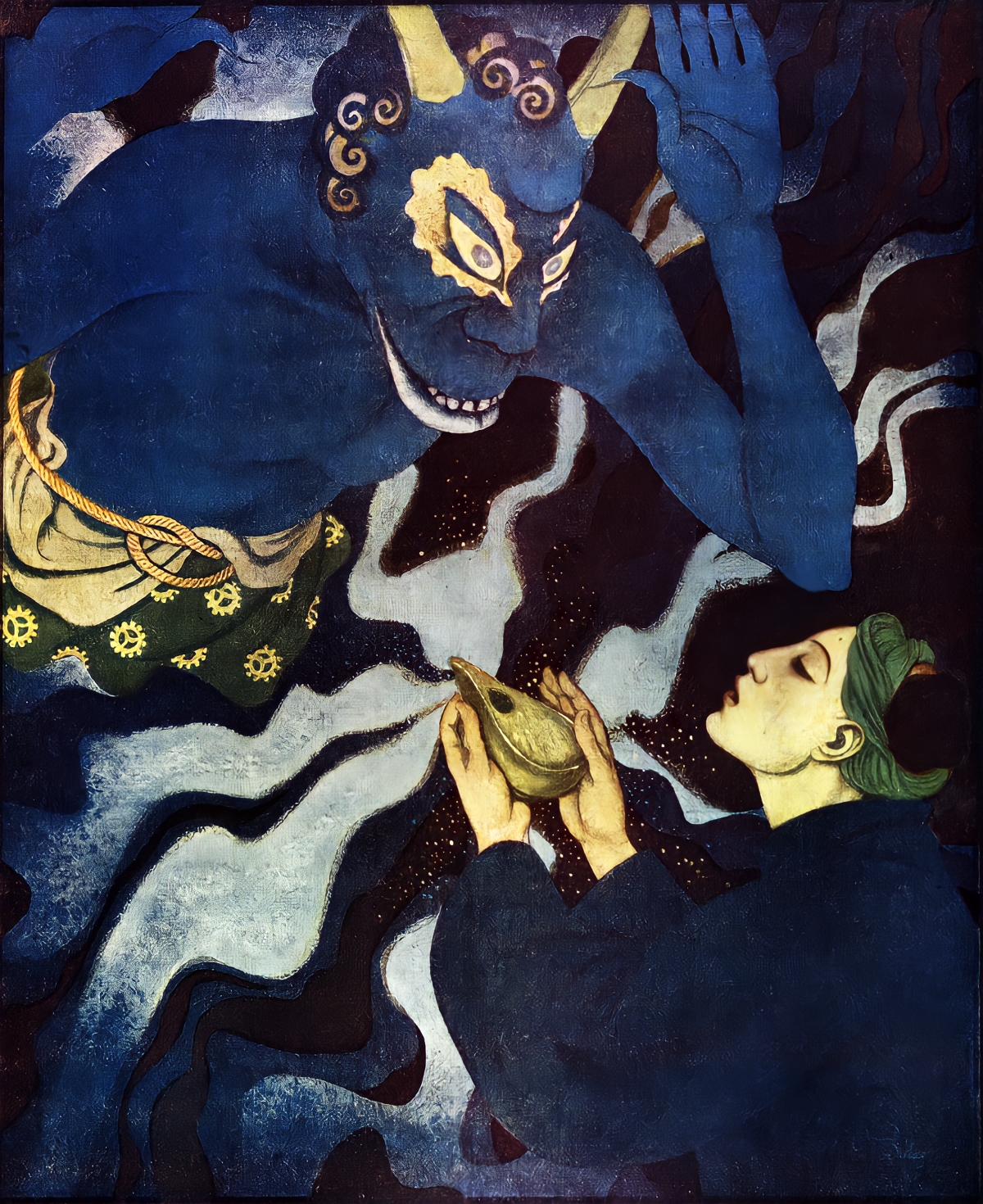
Aladdin and the wonderful lamp

The Princess Badroulboudour–The Sweetheart of Aladdin
Famous “Vamps” of History, 1929
February 24 The Queen of Sheba
March 3 Circe the Sorceress
March 10 Salome of Old Jerusalem
March 17 Atalanta and the Golden Apples
March 24 Yang Kuei Fei–The Chinese Cleopatra
March 31 Ariadne
April 7 Semiramis
April 14 Helen of Troy

Salome of Old Jerusalem
Salome was the daughter of Herodias, who was the wife of Herod, the Tetrarch of Galilee in the time of the Saviour. Her mother hated John the Baptist, who had preached bitterly against her. Salome was a wonderful dancer, and on the birthday of Herod, her stepfather, she danced for him, and so beguiled him that he promised to give her whatever that she would ask. Instructed by her mother she asked for John the Baptist’s head, and Herod had it cut off and brought to her on a platter.
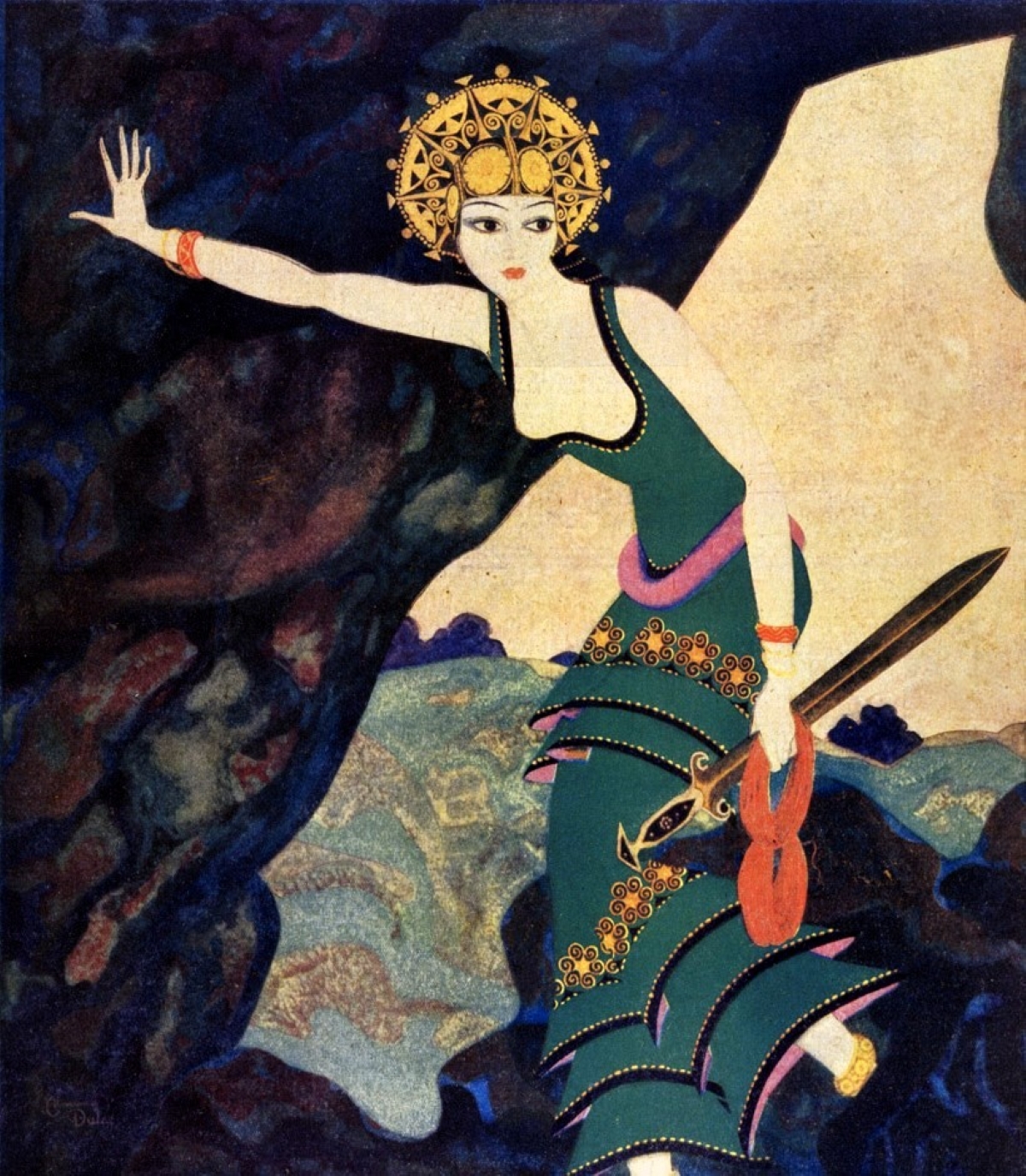
Ariadne
Ariadne, heroine of the Greek poet Homer’s story of the Minotaur, was the daughter of Minos, King of the island of Crete. Once every year Athens had to send a tribute to Crete seven of its most beautiful maidens and seven of its most handsome youths as a sacrifice to the monster, which was half bull and half man. The Greek hero Theseus, son of Aegues, King of Athens, was one of the youths selected. He determined to slay the Minotaur, which lived in a labyrinth, or underground maze of passages, out of which none who entered could make their way without guidance.
When the youths and maidens were exhibited before King Minos, Ariadne fell in love with Theseus. She gave him a sword and provided him with thread by which he might find his way out of the labyrinth after slaying the Minotaur. Theseus slayed the monster and by way of the thread led his companions to safety.
Love Stories the Ancients Believed In, 1931
February 8 Perseus and Andromeda
February 15 Pan and Syrinx
February 22 Psyche and Eros
March 1 Circe and Ulysses
March 8 Orpheus and Eurydice
March 15 Europa and Zeus
March 22 Selene and Endymion
March 29 Hercules and Dejanira
April 5 Persephone and Pluto
April 12 Venus and Adonis
April 19 Medea and Jason
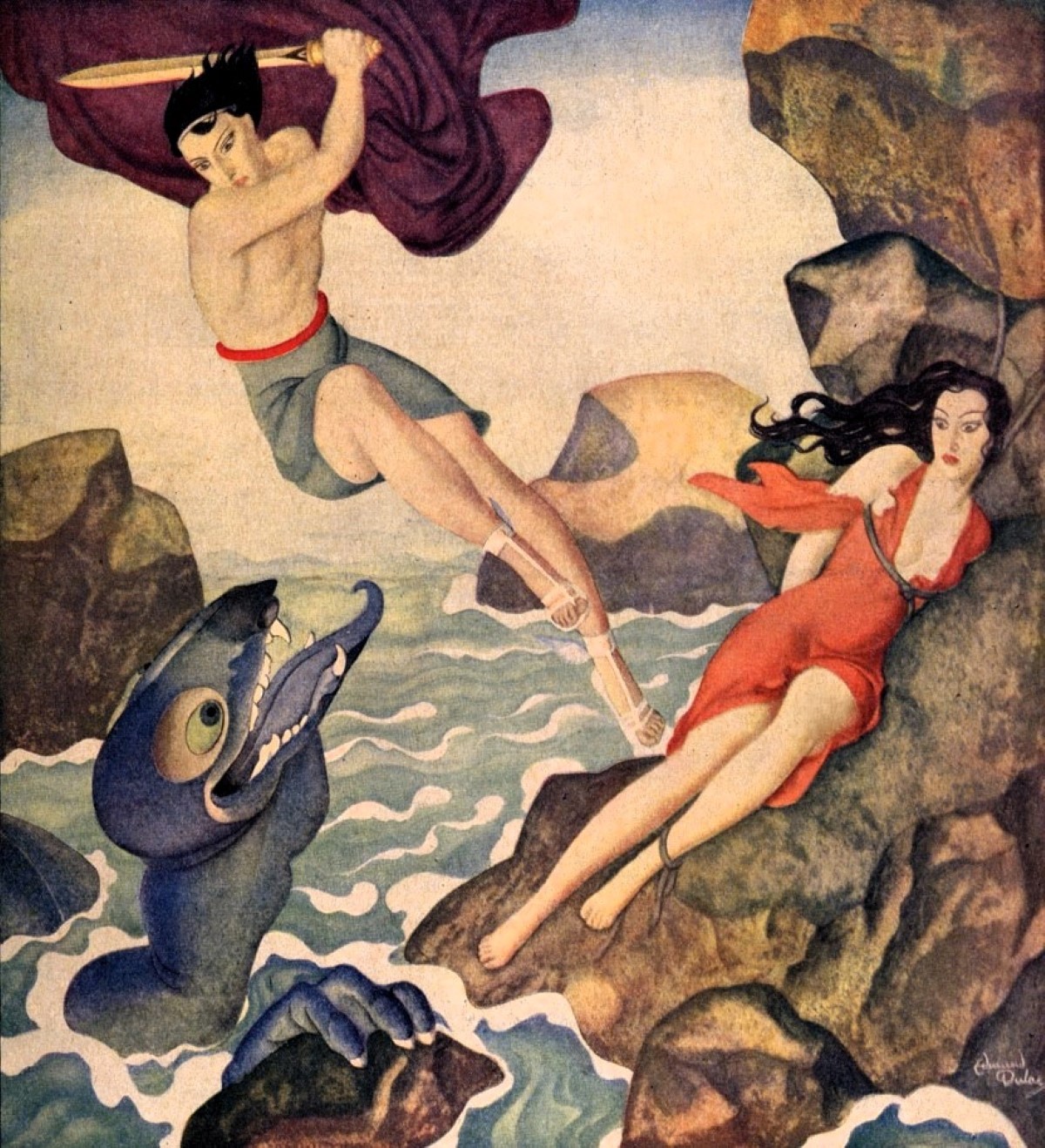
Perseus and Andromeda
Queen Cassiopeia was so beautiful that her husband dared to compare her to the Sea Nymphs. This made them so angry that they sent an enormous sea serpent to ravage the coast of his land. The oracles told the King that if he wanted to get rid of it, he must fasten his daughter, Andromeda, to a rock on the shore. So, this was done, but just as the monster was coming up to eat her, Perseus, the ancient Greek hero, flew along on the winged sandals of the god Mercury. He killed the creature, released Andromeda and they were married. Not only did they live happily ever after, but when they died, they went to dwell with the immortals among the stars, where they can still be seen among the constellations.
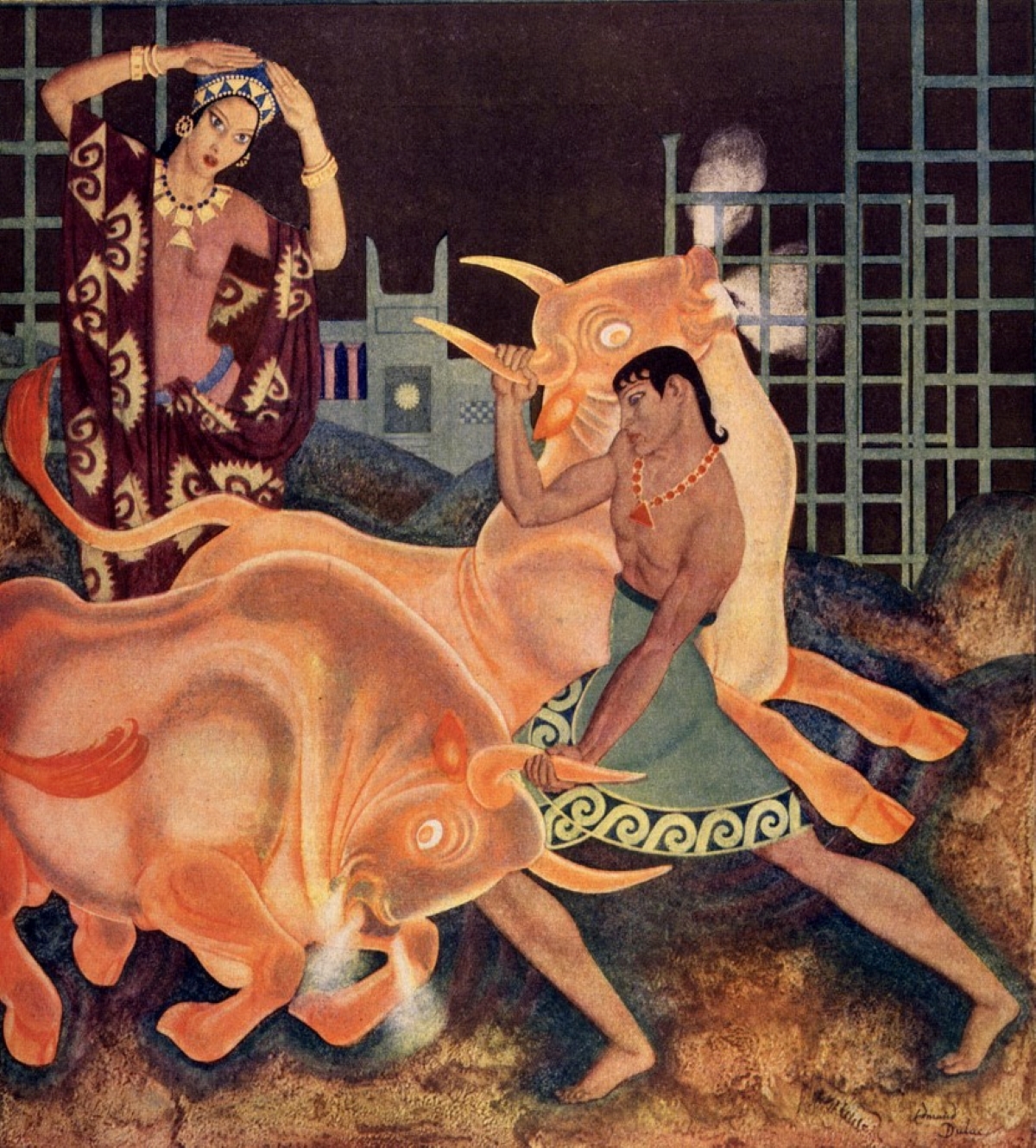
Medea and Jason
The King of Colchis had four singular possessions-a ram’s fleece that was pure gold, a pair of fire breathing bulls with brass feet, dragon’s teeth which sown in the ground turned into soldiers, and a daughter named Medea, who was a sorceress. Jason, a Greek hero, wanted the golden fleece. The King of Colchis promised to give it to him if he would yoke the bulls to a plow and sow the dragon’s teeth. Medea fell in love with Jason. She gave him a charm which protected him against the bulls and allowed him to conquer the dragon teeth soldiers. She even rejuvenated his father with a remarkable potent containing moonlight, sand, pieces of turtle and crow, frost and a screech owl’s head. Jason was ungrateful. He sailed away with the Golden Fleece. Jason’s ship was named the Argo, from which we get the name Argonauts, for gold seekers.
Enchanting Fairyland Lovers, 1932
April 10 Cinderella and Prince Charming
April 17 Prince Ahmed and Peri-Banu
April 24 The Goose Girl
May 1 Ivan and the Chestnut Horse
May 8 The Prince and the Sleeping Beauty
May 15 Ta-Khai and the Bird Feng
May 22 The Princess and the Enchanted Stag
May 29 The Fisherman and the Dragon King’s Daughter
Cinderella had the daintiest little feet. Besides, she had good looks, a heart of gold, a cruel step mother, two cruel step sisters, a fairy Godmother and a depressing life of household drudgery. One night Prince Charming, the King’s son, gave a ball. Cinderella wanted to go but had nothing to wear. She sat crying by the fire. Her fairy Godmother appeared and turned her rags into a beautiful dress and gave her crystal slippers. Then she sent Cinderella off to the party, telling her she must leave before midnight. Cinderella went. The Prince fell in love with her. Just at midnight she ran off, dropping one of her slippers. The Prince went all over his Kingdom trying it on attractive maidens. It didn’t fit. At last he found Cinderella and the slipper fitted. They were married.
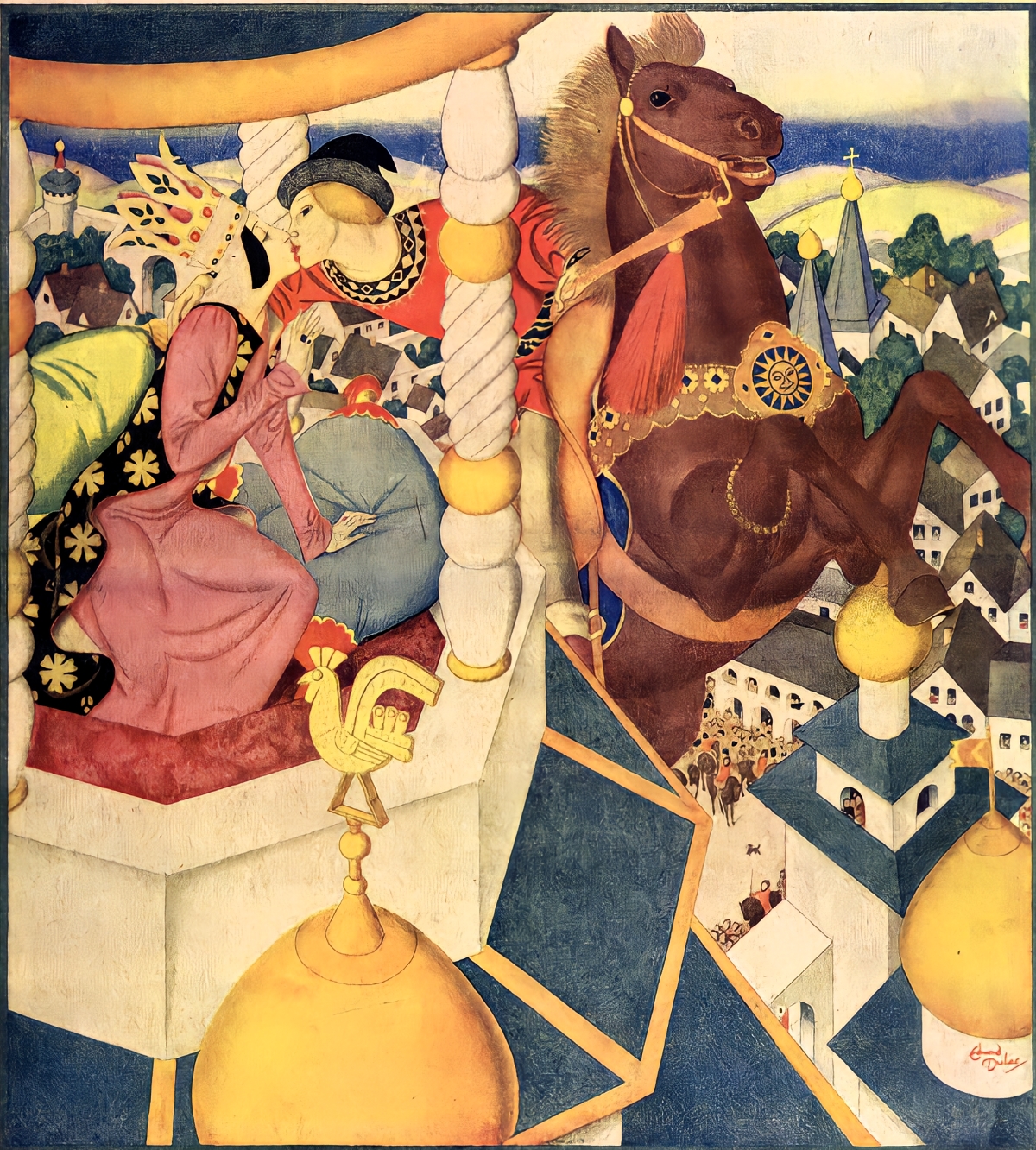
Ivan and the Chestnut Horse
Prince Ivan was youngest and stupidest of three sons. But when his father died, Ivan was the only son to go every day to his grave and read prayers over it. The King had a beautiful daughter whom he kept locked up at the top of a high tower. One day he announced that anyone who could jump his horse high enough to kiss the Princess could marry her. Ivan was sitting on his father’s grave when up rose his father’s spirit and an enchanted chestnut horse. Ivan’s father told him to step into the right ear of the horse and pass out the left. Ivan did it–don’t ask how. When he came out the left ear, he was no longer stupid, but clever, brave and handsome. He trotted the horse to the tower and it leaped up as high as the top and accommodatingly lingered while Ivan gave the Princess a long, long kiss.
She liked it. They married. And so filial piety was rewarded, and the first aerial kiss performed centuries before aeroplanes were thought of.
Myths the Ancients Believed, 1933
April 9 Iris and The God of Sleep
April 16 Echo and Narcissus
April 23 Hercules and Hebe
April 30 Glaucus and Scylla
May 7 Pomona and Vertumnus
May 14 Diana and Actaeon
May 21 Ariadne and Bacchus
May 29 Flora and Zephyr
Halcyone and Ceyx, a King of Thessaly, were still in love, though ten years married. Ceyx went voyaging. His ship was wrecked and everybody drowned. Anxious Halcyone was a widow and didn’t know it. The Goddess Juno was fond of her, yet too tender-hearted to break the sad news. So, she sent Iris, sprite of the rainbow, to Somnus, the God of sleep, to ask him to send a dream to Halcyone to tell her. Isis borrowed Mercury’s winged anklet and rod, took her rainbow and flew to the cave where Somnus slept. The entrance of the dazzling young lady had all the effect of a bomb explosion in a sanitarium for nervous wrecks. Somnus woke up completely for the first time in ages. He sent the dream. Halcyone tried to drown herself. Juno turned her and Ceyx into birds. If Juno could do that, one wonders why she didn’t throw poor Ceyx a celestial life preserver when he so badly needed one. The old gods and goddesses didn’t seem to have much common sense.
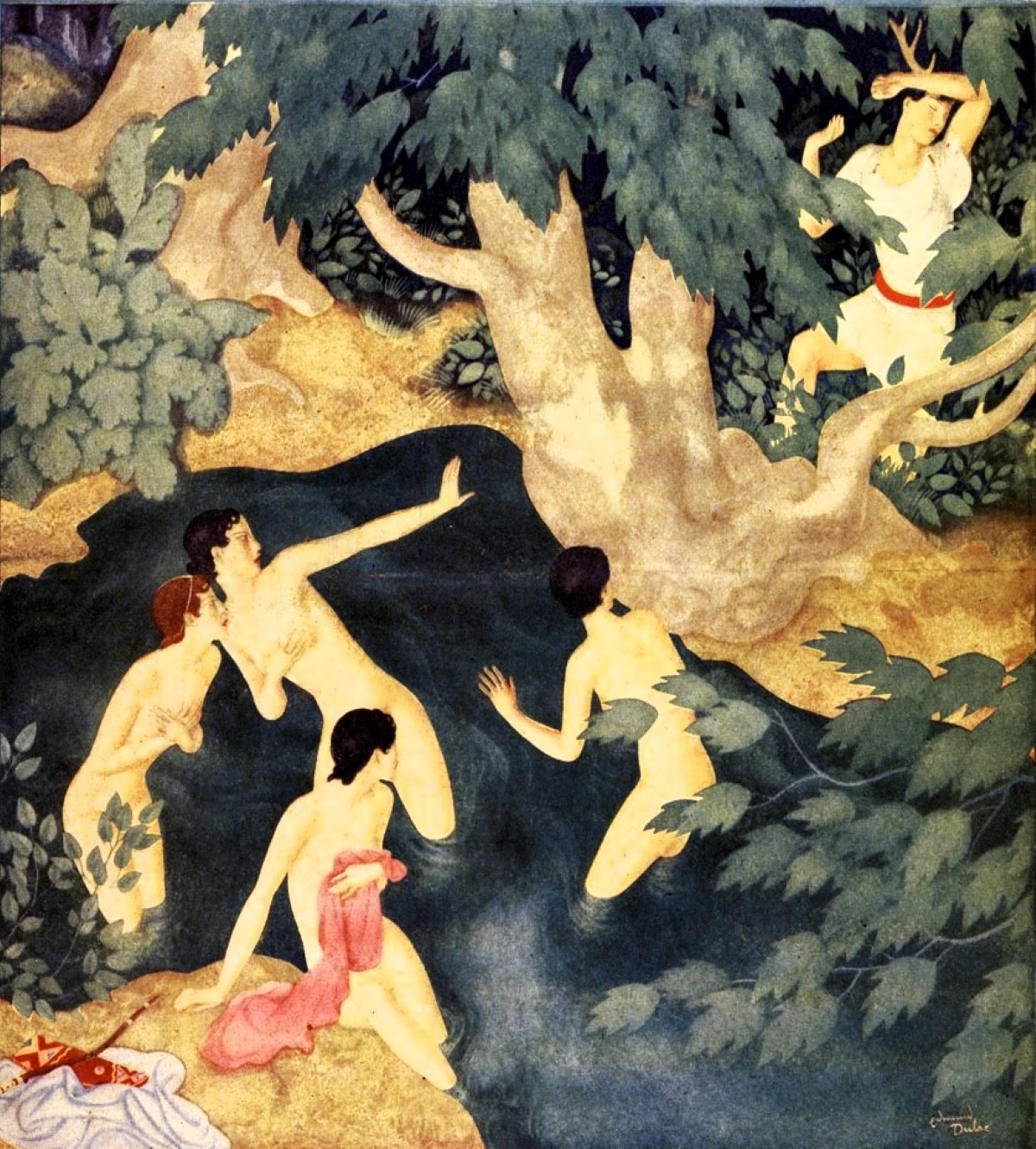
Diana and Actaeon
Diana was the most modest of goddesses. She loved to hunt the bounding stag, but had no patience with men unless they were extraordinarily well behaved. She went about entirely surrounded by Puritanical maidens. One day Actaeon, the King’s son, was out hunting. He stumbled upon Diana taking a bath in her favorite pool with her nymphs. The offended goddess immediately changed him into a stag, crying, “Now try to tell anyone you’ve seen Diana without her clothes.” Actaeon fled. His dogs saw him, thought he was just another deer and chased him. He couldn’t even whistle to them. While they were tearing him to pieces his friends gathered round. He heard them saying what a shame it was that Actaeon wasn’t there. Poor Actaeon earnestly wished that he wasn’t-but couldn’t tell them so. Not till the dogs had killed him was Diana’s wrath appeased. If Actaeon had only stumbled upon Venus instead of Diana, everything would have turned out quite differently.
Follies that Destroyed Famous Queens, 1934
April 29 Semiramis
May 6 Dido
May 13 Cleopatra
May 20 Isabella of Bavaria
May 27 Queen Chand
June 3 Marie Antoinette
June 10 Mary Queen of Scots
Cleopatra was a wise and ambitious queen, by her wisdom and her wiles she managed to cajole Julius Caesar into keeping the rapacious hands of Rome off Egypt. After he was assassinated, she picked Marc Antony for her protector. In BC 31 Antony and Octavian, whom Caesar had adopted, were fighting each other for the mastery of the Roman Empire. Antony’s forces were winning on land, but the sea battle, off Actium, was in doubt. Cleopatra was on one vessel on Antony on another. News was brought to Cleopatra from Athens that a hurricane had torn down a statue of Bacchus, Antony’s patron god, and overturned two of his own. These were dreadful omens. Cleopatra yielded to unreasoning fear and fled. Antony followed. Octavian won. Antony drove a sword through his heart. Cleopatra let a snake bite her and died. Most historians believe that if she had kept her nerve Octavian would have been defeated and the after history of the world changed.

Marie Antoinette
Of Marie Antoinette it has been written that more than anything else her extravagances and insatiable thirst for amusements, during her early years as Queen, brought about the French Revolution. Money was something to be spent, and it was not for her to care from whence it came. Her marriage was loveless and uncongenial. Louis XVI preferred tinkering with clocks to tete-a-tetes with her. She sought consolation in an intimacy-afterwards cruelly misrepresented-with a gay but greedy set who used her to enrich themselves. She plunged into prodigality’s and costly fantastic fetes when the country was suffering from starvation. For seven years she remained childless. With the birth of her first child, she became a devoted mother, but it was too late. The revolution had been born also. The mob broke into the Telleries on June 20, 1792, vilely insulted the Queen and her children, put a red cap on little Dauphine, and dangled Marie Antoinette’s crowned effigy before her eyes. And not long after, the blade of the guillotine fell upon Louis’ neck and hers.
The Song of Solomon, 1936
April 12 “If Thou Know not, O thy fairest Among Women”
April 19 “My Beloved is Like a Roe or Young Hart”
April 26 “It was but a little that I passed from them”
May 3 “Awake O north wind”
May 10 “I sleep but my heart waketh”
May 17 “Whither is thy beloved gone?”
May 24 “How beautiful are thy feet with shoes”
May 31 “We have a little sister”

Her companions advise the Shulamite woman, seeking her lover, who tends his flock, she knows not where, to follow the tracks of the sheep.
“If thou knowest not, O thou fairest among women, go thy way forth by the footsteps of the flock, and feed thy kids besides the shepherd’s tents.”
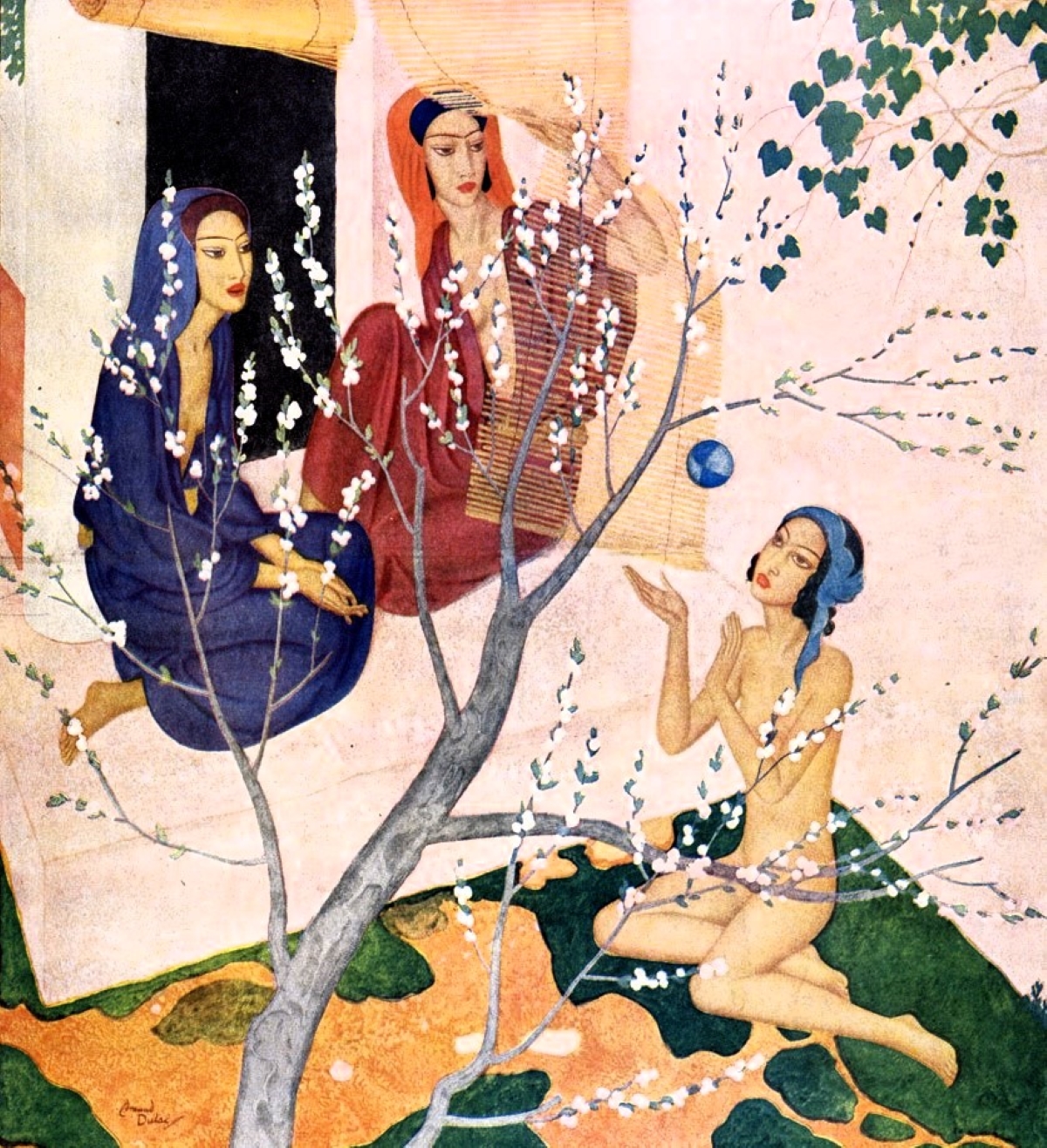
Chapter 1, Verse 8
“We have a little sister… what shall we do for our sister in the day when she shall be spoken for?”
“If she be a wall, we will build upon her a palace of silver: and if she be a door, we will inclose her with boards of cedar.”
Chapter 8, Verses 8-9
Beauty and the Beast, 1937
March 28 Maids of Athens and the Minotaur
April 4 Nymphs and Satyrs
April 11 Saint Martha and the Dragon
April 18 The Centaurs and the Lapithae Women
April 25 The Maid and the Unicorn
May 2 The Hippogriff
May 9 Hanuman Bids Sita Farewell
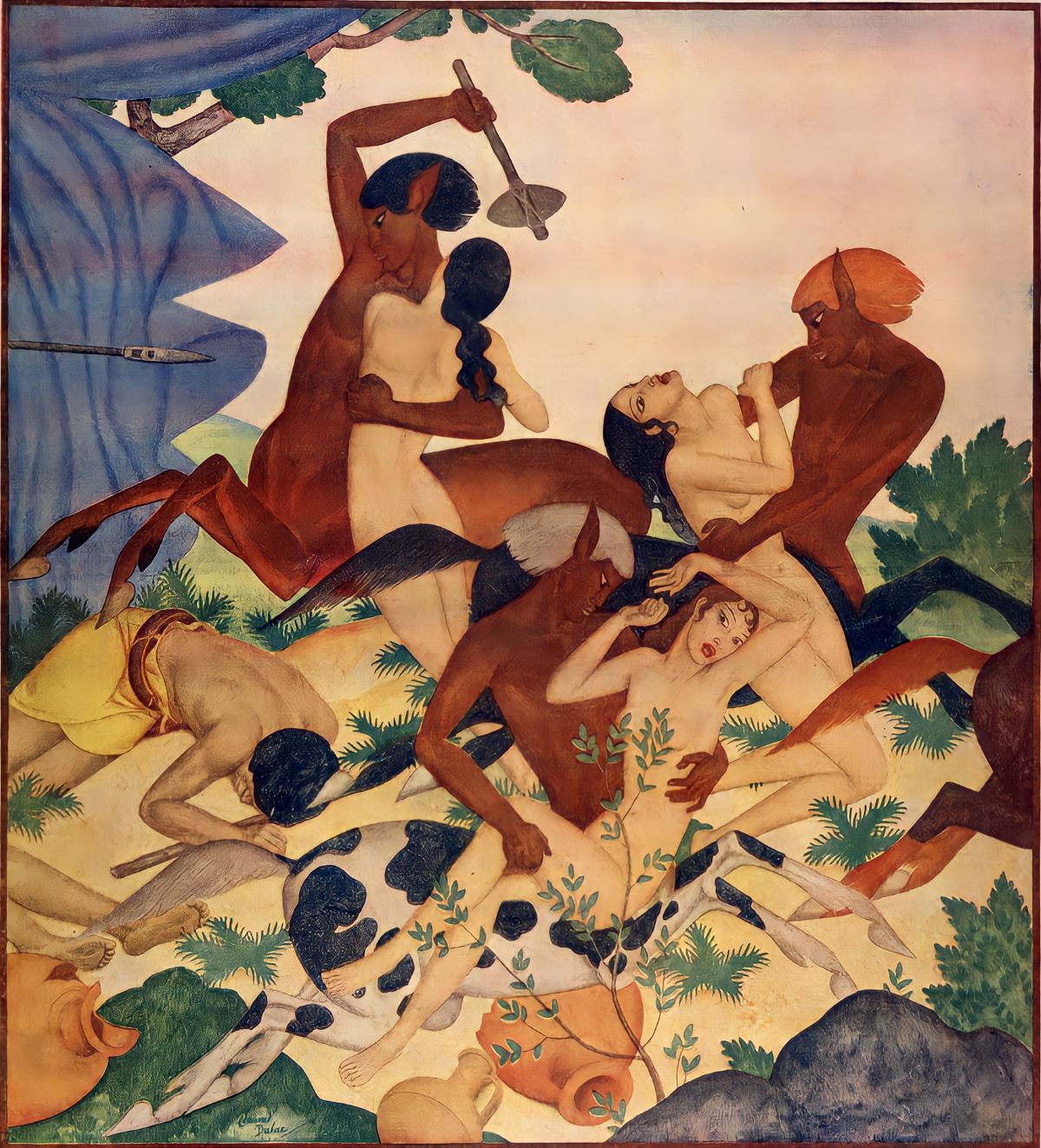
The Centaurs and the Lapithae Women
Many violent struggles of Greek mythology were fitly located in rugged Thessaly in the dawn of history when gods and men often mingled. There was a king of Lapithae named Ision who took advantage of Zeus’ hospitality and made love to the goddess Hera, who cleverly let him play around with a cloud shaped like herself. From this curious romance sprang the Centaurs, half man and half horse.
Although Ision was bound in an eternal wheel for boasting he loved Hera, his earthly son named Pirithous carried on. When Pirithous married Hippodamia, the Centaurs were asked to the wedding feast. But excited by the new experience of wine, the wild Eurythion seized the bride, and his Centaur companions followed suit with her ladies-in-waiting. But at last, the horse men were driven away.
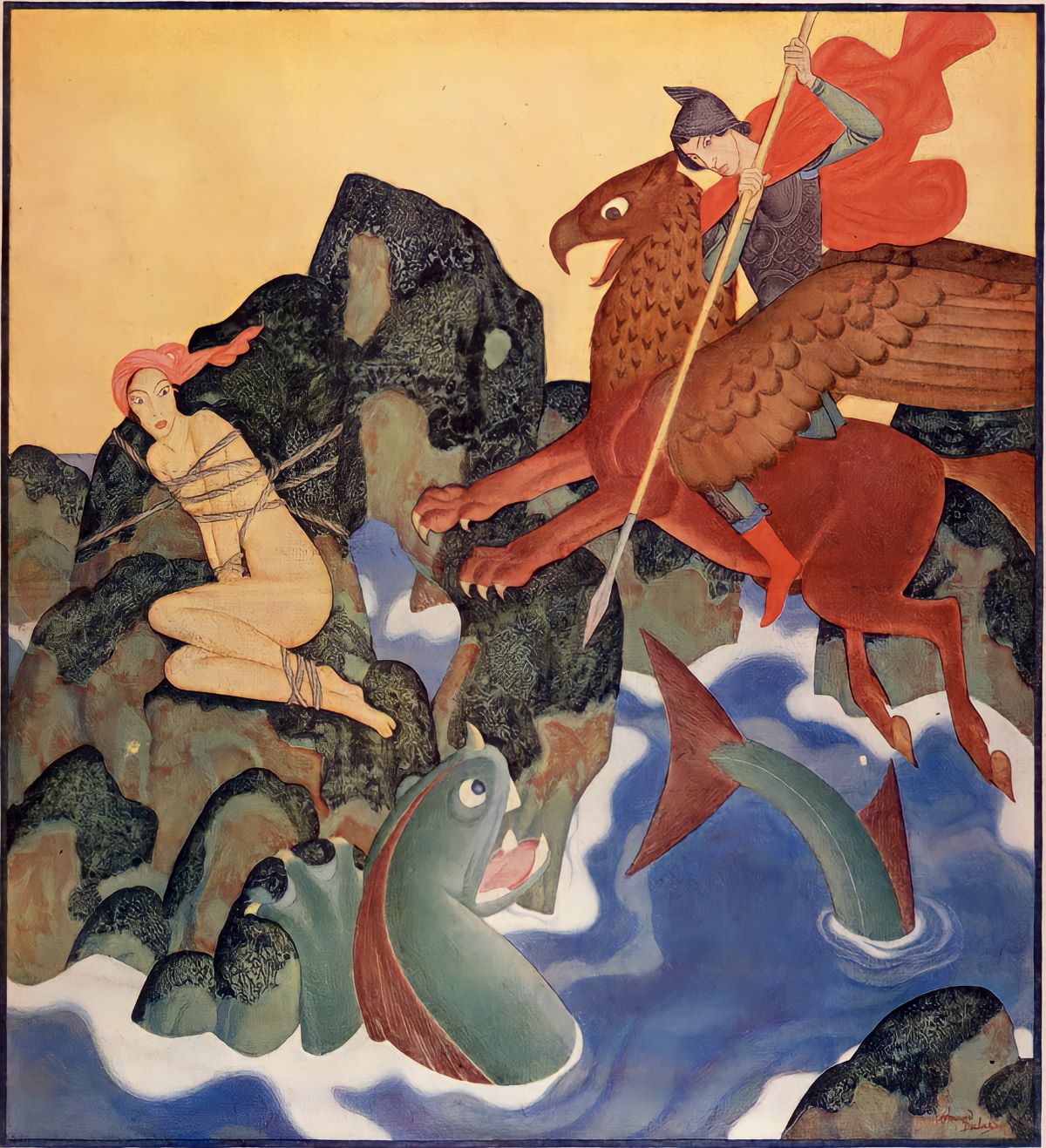
The Hippogriff
The Fairest of her sex, Angelica, had been tied to a rock by the islanders off the Irish coast, because an oracle told them that only with a virgin could they appease the anger of the Orc, a sea monster which was coming to devour them all. Rogero, who happened to be flying by on his marvelous Hippogriff, saw the unhappy princess and came down just as a mighty roar announced the Orc’s coming.
Seeing the shadow of the Hippogriff’s wing the Orc has turned to fight the intruder. Rogero is about to plunge his lance into the trashing sea beast whose huge paw already reached for Angelica. But only with his mighty buckler will brave Rogero destroy the animal, for its scales are impenetrable. This fable has come down from “Orlando Furioso” by the brilliant 15th century Italian Ariosto.
Fighting Women, 1938
June 5 Penthesilea
June 12 Hippolyte and Hercules
June 19 Thomyris
June 26 Zenobia
July 3 Joan of Arc
July 10 Mu-Lan
July 17 Molly Pitcher
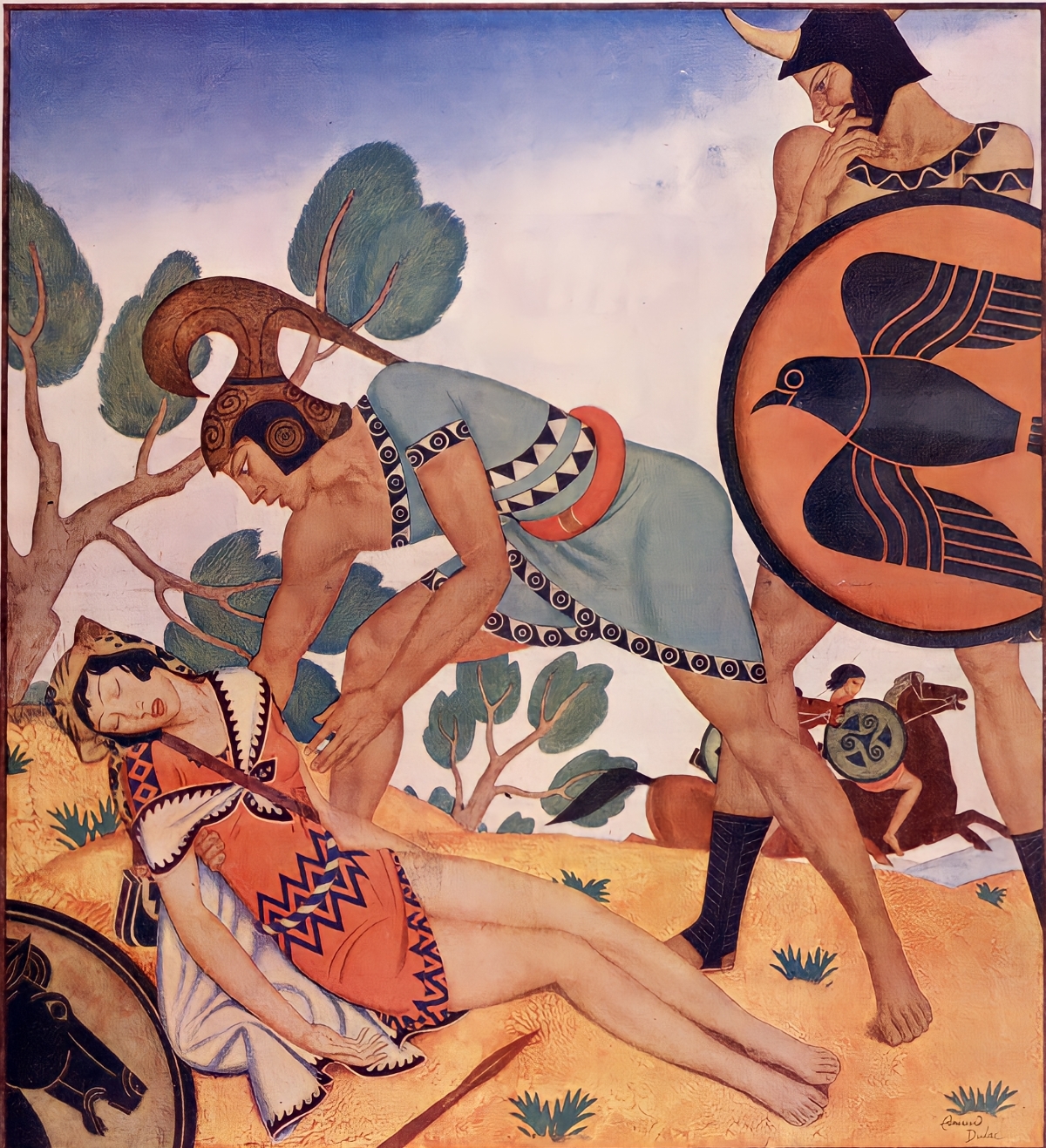
Penthesilea
Among the greatest of fighting women was Penthesilea, beautiful amazon Queen who, the Greek epic poet Homer tells, led her women soldiers to help defend Ancient Troy after the godlike Hector was slain. Her Amazons fought the Greeks, blow for blow, their skirling war cry striking fear in the bravest of hearts. Nor could any man withstand Penthesilea, warrior queen, except Achilles, noblest of Troy’s enemies, whose javelin pierced her heart.
Here green robed Achilles gazes down at her, and moved by her beauty, grieves over his victory. The villainous Thersites mocks his sorrow. Nor will Thersites bird-faced shield hold off the death blow Achilles is about to give him.

Thomyris
Thomyris was the Queen of the Massagetae, a strange tribe that inhabited the region south of the river Jaxartes in Asia. She lived more than five centuries before the birth of Christ, on the west slope of the Tian Shan, or “Celestial Mountains” that divide China and Russia. Her people were said to eat their aged relatives. They were also fabulously rich, and preferred to use gold instead of iron for all their needs.
Perhaps inflamed by these legends, Cyrus, the Persian conqueror, invaded the lands of Thomyris in 529 BC. He rued the day, however, for the head that is being shown to the gorgeous and bejeweled queen on this page is Cyrus’ very own. Thromyris defeated him in battle and had him shortened by a head. Her arm is raised in triumph, while her oriental slaves in blue breeched display her cause for rejoicing.
Seven Tales from King Arthur’s Court, 1940
February 4 The Tale of Arthur’s Sword “Excalibur”
February 11 The Tale of Sir Tristram and the Love Potent
February 18 The Tale of The Enchantress and the Magic Scabbard
February 25 The Tale of Sir Galahad and his Quest for the Sangreal
March 3 The Tale of Lancelot and the Four Queens
March 10 The Tale of Merlin and One of the Ladies of the Lake
March 17 The Tale of How Sir Lancelot Slew Sir Agravaine

The Tale of Arthur’s Sword “Excalibur”
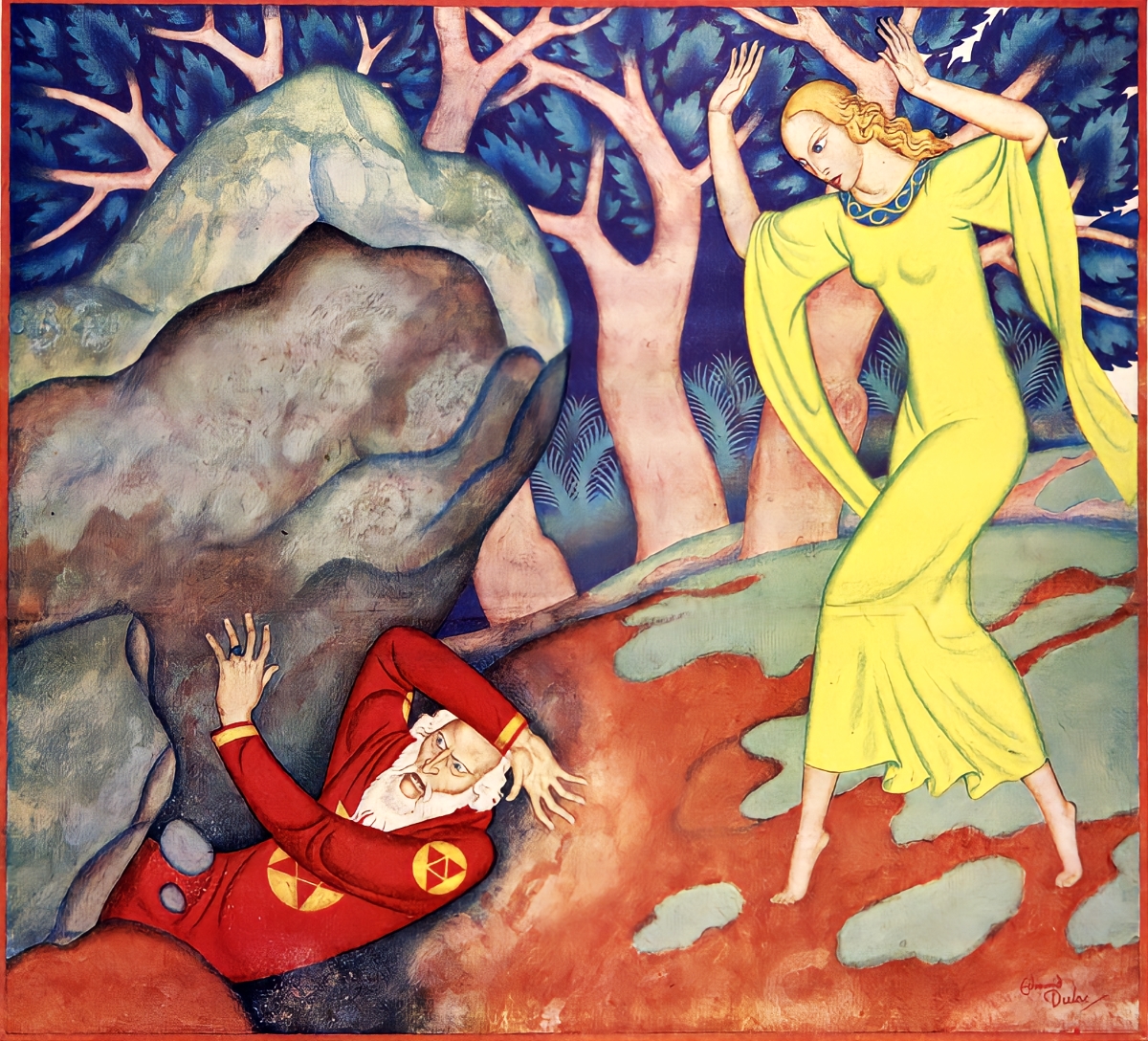
The Tale of Merlin and One of the Ladies of the Lake
8 Canterbury Tales, 1942
August 9 The Student’s Tale of Patient Griselda
August 16 The Knight’s Tale of Emily’s Lovers
August 23 The Miller’s Tale of the Carpenter’s Wife
August 30 The Squire’s Tale of Canace and the Talking Falcon
September 6 The Wife of Bath’s Tale of the Amorous Knight
September 13 The Merchant’s Tale of the Doting Husband
September 20 The Man of Law’s Tale of what Happened to Constance
September 27 The Second Nun’s Tale of Saint Cecilia
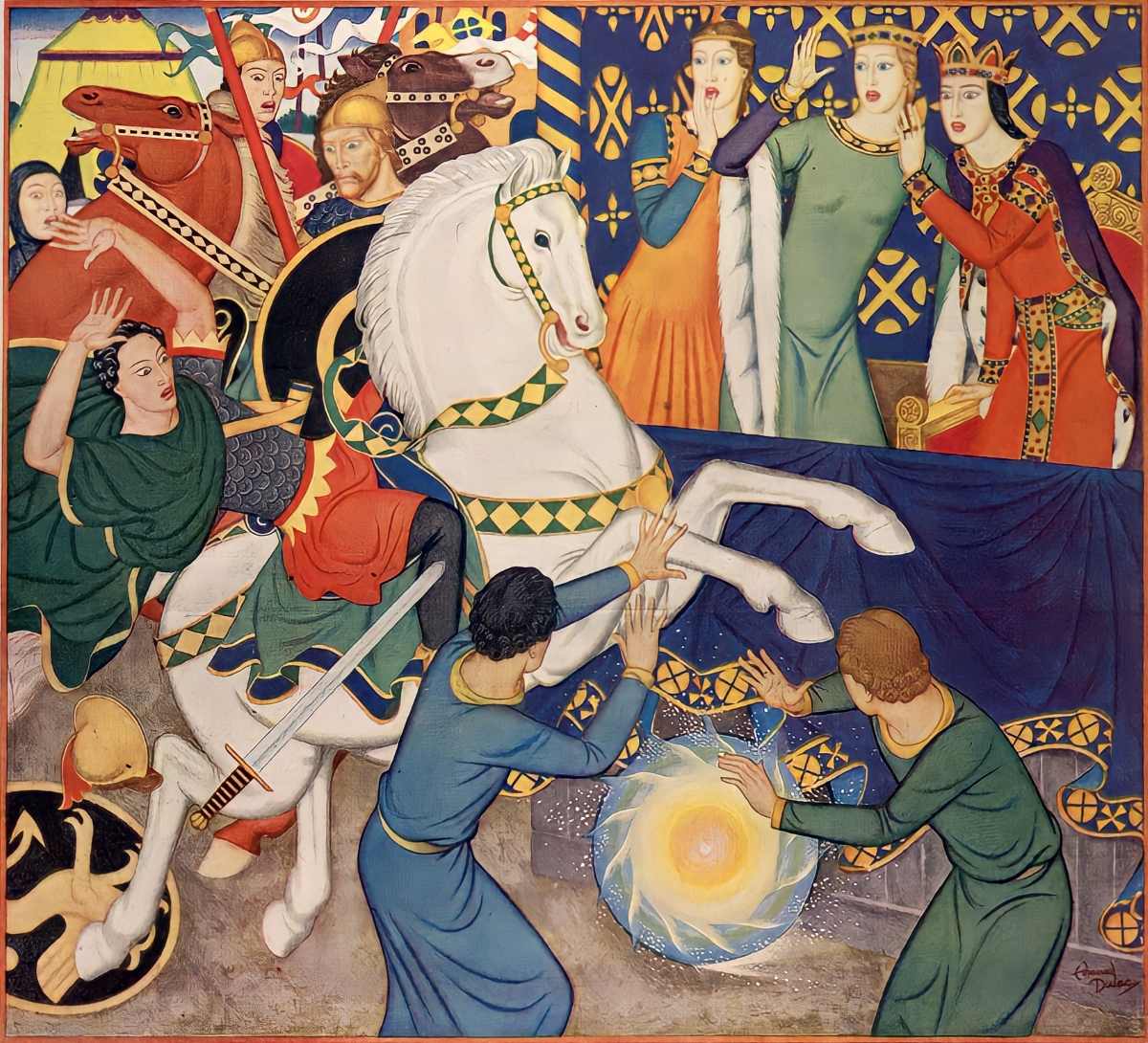
The Knight’s Tale of Emily’s Lovers
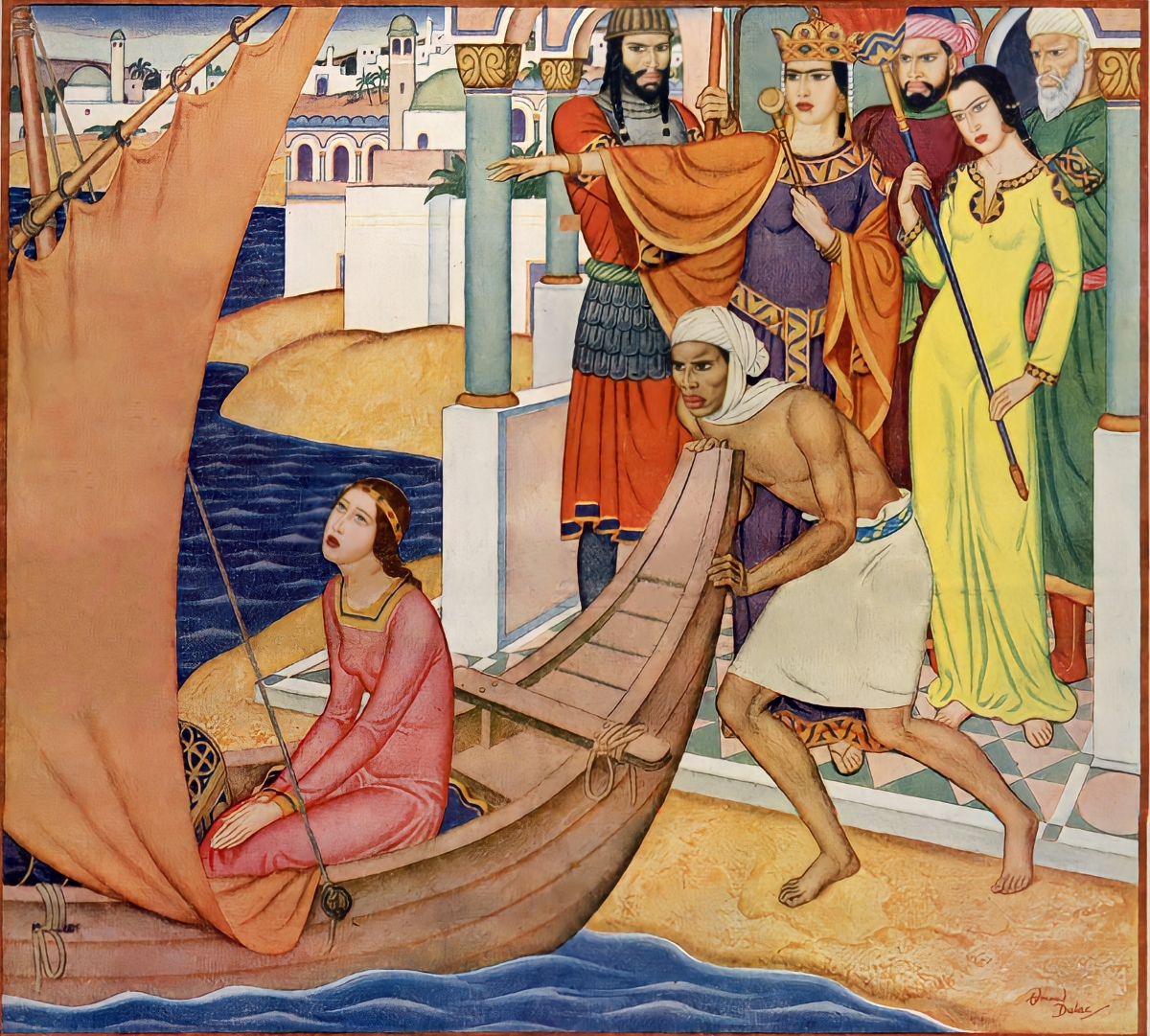
The Man of Law’s Tale of what Happened to Constance
Tales from The Arabian Nights, 1950-1951
December 31,1950 The Genie Dehnesh brings Princess Budour to compare her with Prince Kemerezzeman
January 7, 1951 Princess Budour, reigning disguised as a king, often sat on a balcony overlooking the sea, hoping the next ship would bring her beloved
January 14 Prince Ahmed and the Fairy Princess Perie-Banou
January 21 Prince Ahmed Finds the Sorceress
January 28 Ali Baba dumps bags of gold before his amazed wife
February 4 Morgiana dances with the dagger before Ali Baba and the Captain of the thieves
Edmund Dulac, whose illustration of this story appears on the cover, is one of the world’s most famous fairy tale artists. He was born in Toulouse, France, 1882, and studied in French art schools. He became a British citizen in 1912, and lives in London today. He first illustrated “The Arabian Nights” in 1907, and in 1913 illustrated a special edition of the tales of Princess Budour.
Watson Crewes, Jr.

Prince Ahmed Finds the Sorceress
Bibliography
Blackbeard, William, (1977) Smithsonian Collection of Newspaper Comics, Smithsonian Inst. ISBN: 978-0-874-74172-8
Bill Blackbeard’s collection at Ohio State University-
Peter Beard’s YouTube video of ‘The Fantasy Art of Edmund Dulac’-
White, Colin (1976). Edmund Dulac, Charles Scribner’s Sons ISBN: 978-0-684-14791-8.
Hughey, Ann C. (1995). Edmund Dulac – His Book Illustrations: A Bibliography, Buttonwood Press ISBN: 978-0-964-53951-8
Larken, David (1975) Dulac, Charles Scribner’s Sons, ISBN: 978-0-684-14414-6
Menges, Jeff (2011), An Edmund Dulac Treasury: 116 Color Illustrations, Dover Publications, ISBN: 978-0-486-47911-8
Seligman, Albert, (2021), The American Weekly Covers of Edmund Dulac, Dulacebooks, ISBN: 978-0-578-95087-7
(2023) Seven Tales From King Arthur’s Court, Markosia, ISBN: 978-1-915860-09-5
Would you like to support Flashbak?
Please consider making a donation to our site. We don't want to rely on ads to bring you the best of visual culture. You can also support us by signing up to our Mailing List. And you can also follow us on Facebook, Instagram and Twitter. For great art and culture delivered to your door, visit our shop.


